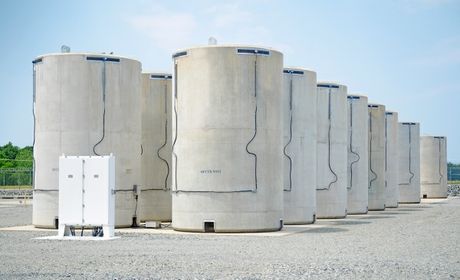 McGuire Nuclear Station dry cask storage stores used fuel on site.
McGuire Nuclear Station dry cask storage stores used fuel on site.One aspect of nuclear energy that makes it unique is the issue of used fuel storage. Used fuel is nuclear fuel that is no longer useful for sustaining a chain reaction in a reactor. While the fuel is no longer useable for producing electricity, it continues to give off radiation and heat and must be stored properly.
The United State government has promised electric utilities it will create a long-term storage solution for used fuel, but that has not yet came to fruition. The Nuclear Regulatory Commission has selected Yucca Mountain as a potential disposal site but has been contested. Until the government makes a decision regarding the long-term storage location of spent fuel, nuclear facilities are either store it onsite or send it to specially equipped landfills. While a central repository for used nuclear fuel is the long-term goal, nuclear facilities are well equipped to safely handle the storage of used fuel on site.
After being removed from the reactor, used fuel spends approximately five to ten years in a large, deep pool of water on site known as a used fuel pool. The water cools the fuel and acts as a radiological barrier. Once the fuel cools down to an appropriate temperature and meets strict radiological and chemical requirements, it is moved to dry cask storage.
The cask is a round, stainless steel canister that holds approximately 24 used nuclear fuel bundles. Dry cask storage means exactly that – dry. The water that is in the cask when it is loaded with fuel is pumped out through siphon ports and backfilled with helium to ensure it is dry. It is protected by a reinforced concrete building called a horizontal storage module.
The fuel is permanently cooled through a system of natural circulation. The horizontal storage module has vent ports located in the front of each module that allow air to flow around the canister and back out again. In addition, nuclear professionals monitor the modules by performing observations and using radiation and temperature monitors.


